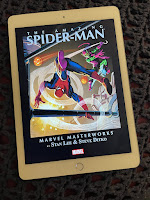 We caught The Hobbit: An Unexpected Journey last weekend, so I thought I'd check in about it. We did an across-the-board upgrade that day. We upgraded to IMAX. We upgraded to 3-D. We upgraded to high frame rate (HFR). We couldn't have spent any more money seeing this movie if our lives depended on it. So, after all that, how was it?
We caught The Hobbit: An Unexpected Journey last weekend, so I thought I'd check in about it. We did an across-the-board upgrade that day. We upgraded to IMAX. We upgraded to 3-D. We upgraded to high frame rate (HFR). We couldn't have spent any more money seeing this movie if our lives depended on it. So, after all that, how was it?
The movie itself was terrific. Great characters, great action, an absorbing story, all working together to make the close to three hours fly by. I've never been a big basher of George Lucas, but this particular prequel trilogy looks like it will get everything right: reminding us of everything we loved about the original franchise trilogy while carving out its own, equally wonderful story.
The 3-D was done well, free of silly coming-at-you effects, and concentrating on subtle, artful immersion of the audience into the drama at hand. It definitely added another level of fun to the movie. Of course, I've never been a big basher of 3-D as most movies employ it these days, so keep that in mind when deciding whether to see it yourself in 3-D.
Ah, now to discuss the new 48-frames-per-second high frame rate (HFR) technology. Contrary to some of the things you may have read, HFR does not result in a cheap, shoddy looking image in any way. More specifically, the process itself isn't cheap and shoddy, and it doesn't make the subject matter being filmed look cheap and shoddy. But it does make everything look more real, like you're standing right there on the set with the actors. That means- and this is important- you're not going to get the rich, burnished colors and moody lighting that, say, director of photography Roger Deakins provided for the gorgeous Skyfall.
To try to put it another way, HFR largely removes the layer of artful cinematography movies usually provide and puts you right there in Bilbo's hobbit hole and on the many rickety wooden bridges and walkways our heroes seem to be constantly running across while some menace or other is chasing them. In some ways, because you're right there, it is amazing, but other times I felt like I wasn't getting my money's worth. Where was the painterly pallette of colors and light? Where was the sometimes subtle, sometimes overt use of that pallete by a skilled cinematographer? In the end, HFR, at least in this movie, reminded me of quality, high-end videotape: the result was very realistic, but often not terribly artistic.
But, yes, I'm glad I experienced the HFR process first hand, and I'm definitely glad I saw The Hobbit: An Unexpected Journey. I'll definitely be there opening day next year for The Hobbit: The Desolation of Smaug. But will I be in the HFR line? We'll see. I have about a year to think about it!
Review postscript: To be full disclosure, my wife had no problem with the HFR process, finding it fascinating and especially liking how it made all the outdoor scenery really pop. And, like me, she also enjoyed the 3-D and the movie itself. So, who knows, maybe my concerns relating to HFR are just film geek ramblings and nit-picking. I'll keep an open mind for the time being.



A mind challenging puzzle game for kindlefire. Check it out!
ReplyDeletehttp://www.amazon.com/Door-Revenge-Kindle-tablet-Edition/dp/B00BFRXDRE